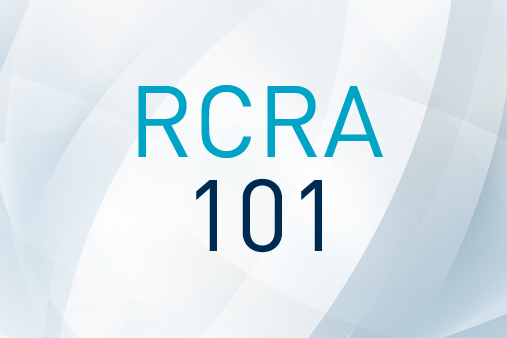Waste materials meeting the definition of solid waste, and then also meeting the definition of a hazardous waste as detailed in 40CFR §261, must undergo treatment in most cases to destroy, immobilize, or greatly reduce the hazardous constituents present. The nature of a hazard or hazards present in a waste is defined by assigning one or more applicable 4-character alphanumeric hazardous waste numbers in §261. Hazardous wastes requiring treatment are subject to one or more treatment standards detailed in 40CFR §268 corresponding to the assigned hazardous waste numbers.
Treatment standards may be either technology-based, or concentration based. Technology-based standards, such as INCIN (incineration), define a specific method of treatment to be performed. Concentration-based standards set a specific chemical concentration. Treated waste must be tested to ensure that it does not exceed the specified concentration before it may be landfilled.
It is the hazardous waste generator’s responsibility to notify the assigned treatment, storage, and disposal facility (TSDF) of waste being shipped which does not meet all applicable treatment standards. This is done by completing a generator-certified and signed Land Disposal Restriction (LDR) notification document, which accompanies the hazardous waste manifest used to initially ship the waste. This document certifies that the waste may not be placed in a landfill until all applicable treatment standards have been met. That is why the LDR notification document is commonly referred to as the “Land Ban.” Should any revisions be made to the waste, a corresponding LDR notification revision must accompany the subsequent shipment.
LDR notifications have several components which help define the hazard(s) of the waste and applicable treatment options, as shown in the §268 table. The treatment standards themselves do not have to appear on the LDR notification, but the information provided should make it possible to locate the proper standard in the §268 table if necessary. Although there is no set document format, the following items are commonly part of the LDR notification.
- Manifest Document Number – to link the LDR notification to the applicable shipping manifest
- Generator and TSDF information
- The Hazardous Waste Number – alphanumeric 4-digit codes defining a waste characteristic and/or contaminant.
- Some hazardous waste numbers are divided into subcategories, one of which must be selected. For example, D001 (ignitability) has a “High TOC Ignitable Liquid” subcategory for flammable organic liquids, and simply “Ignitable except for High TOC Liquids” for flammable solids, dilute flammable liquids (less than 10% TOC) and oxidizers (solids or liquids). Each subcategory has its own assigned treatment standards.
- Wastewater or non-wastewater designation as applicable.
- The “common name” is a list of one or more chemical compounds (hazardous constituents) applicable to the hazardous waste number.
- Underlying Hazardous Constituents: These are applicable hazardous constituents of a waste which are not already defined by a hazardous waste number. In the §268 table, several of the characteristic waste numbers beginning with “D” have language in their treatment standard which says “…and meet §268.48 standards.” This is a table known as the UTS or Universal Treatment Standards table. So, for example if a waste is assigned D008 for lead non-wastewater and also has nickel present above the 11 mg/L TCLP treatment standard in the UTS table, then nickel must also be noted in the hazardous constituents section as a constituent requiring treatment.
- Certification: This is the notification from Generator to TSDF. Most commonly this informs the TSDF that the given waste(s) have been properly characterized and require treatment to the applicable standards set forth in the document. There are special certifications which notify the TSDF that the generator would like their waste treated using an applicable alternate treatment standard (i.e. for soil or debris, as defined under RCRA).

